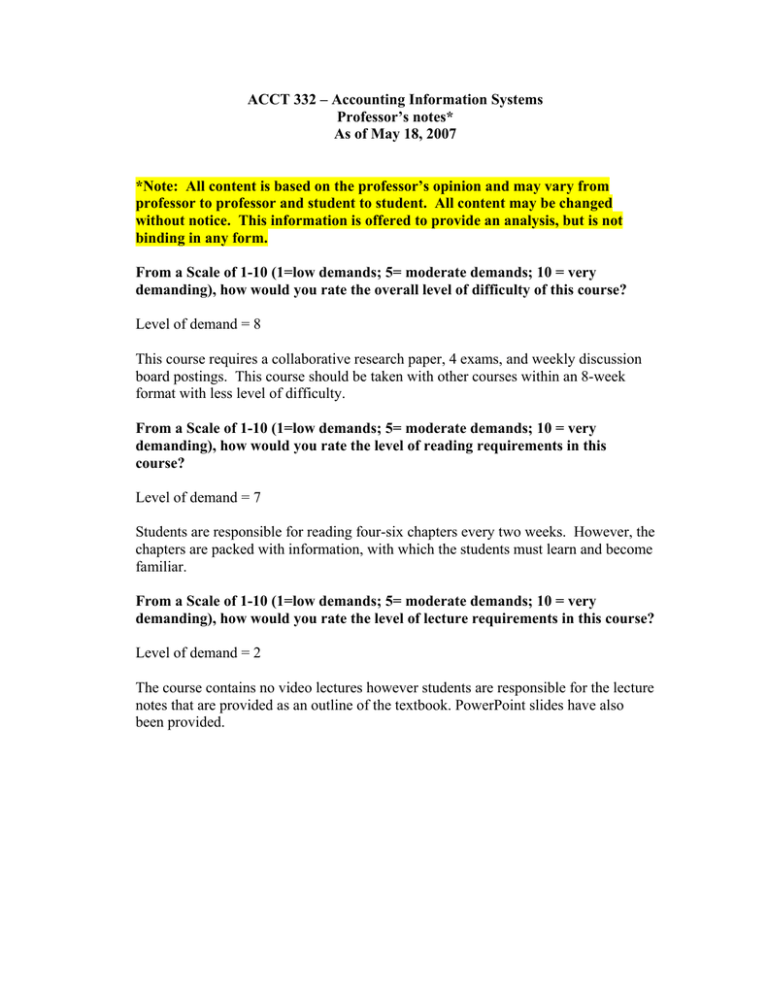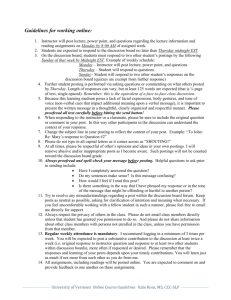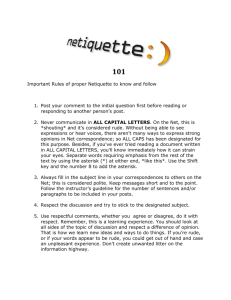
ACCT 332 – Accounting Information Systems
Professor’s notes*
As of May 18, 2007
*Note: All content is based on the professor’s opinion and may vary from
professor to professor and student to student. All content may be changed
without notice. This information is offered to provide an analysis, but is not
binding in any form.
From a Scale of 1-10 (1=low demands; 5= moderate demands; 10 = very
demanding), how would you rate the overall level of difficulty of this course?
Level of demand = 8
This course requires a collaborative research paper, 4 exams, and weekly discussion
board postings. This course should be taken with other courses within an 8-week
format with less level of difficulty.
From a Scale of 1-10 (1=low demands; 5= moderate demands; 10 = very
demanding), how would you rate the level of reading requirements in this
course?
Level of demand = 7
Students are responsible for reading four-six chapters every two weeks. However, the
chapters are packed with information, with which the students must learn and become
familiar.
From a Scale of 1-10 (1=low demands; 5= moderate demands; 10 = very
demanding), how would you rate the level of lecture requirements in this course?
Level of demand = 2
The course contains no video lectures however students are responsible for the lecture
notes that are provided as an outline of the textbook. PowerPoint slides have also
been provided.
From a Scale of 1-10 (1=low demands; 5= moderate demands; 10 = very
demanding), how would you rate the level of online exam requirements in this
course?
Level of demand = 9
The course has 4 online tests (one every two weeks). Although they are open book
and open notes, students are responsible for all material found in the book. Questions
come from an extensive exam database.
From a Scale of 1-10 (1=low demands; 5= moderate demands; 10 = very
demanding), how would you rate the level of discussion board requirements in
this course?
Level of Demand = 9
In weeks 1, 3, 5 and 7 students will answer a question found in the course content
section. The questions will cover topics found in the chapters relating to those being
tested. In addition, students will also respond to one other student. Integration of
different articles and a good grasp of the topic are encouraged. References and
citations must follow APA format as the paper requires APA.
In weeks 2, 4, 6 and 8 students will respond to an instructor posed question that
summarizes the information covered. Students may be required to also respond to
other students thus increasing the value of the discussion.
From a Scale of 1-10 (1=low demands; 5= moderate demands; 10 = very
demanding), how would you rate the level of the written paper requirements in
this course?
Level of Demand = 9
Additional Comments:
The course requires a major research paper of 8 pages in length. The paper must be
written in APA format, with proper formatting, in-text citations and academic
references. Students who have not previously written a research paper, or have been
out of academics for many years, may experience difficulty with this assignment.
The research for and writing of the paper should take place over several weeks; it is
not an assignment that can be completed in one weekend as it is a collaborative effort
with other classmates.
This course moves quickly, therefore students should expect to be very busy for the
duration of the course. There are assignments due each week.
COURSE SYLLABUS
SCHOOL OF BUSINESS
ACCT 332
ACCOUNTING INFORMATION SYSTEMS
COURSE DESCRIPTION
This course provides a basic knowledge of how accounting information systems
function in today’s business environment. It emphasizes the internal control features
necessary to produce accurate and reliable accounting data as it looks at how
accounting information is recorded, summarized, and reported in both manual and
computerized systems.
The following topics are covered in this course: Systems concepts, tools, development
processes, analysis, design, implementation and operation, computer software and
configurations, data storage and processing methods, file processing, implementing
data base management systems, internal control, information system controls, data
security and integrity, accounting transaction cycles, revenue cycle applications, and
expenditure cycle applications.
RATIONALE
This course is intended to prepare students for careers in accounting as users,
managers, auditors and designers of accounting information systems. The course will
help students gain an appreciation for accountants’ dual roles as both purveyors and
consumers of accounting information. It will provide students with a broad
conceptual knowledge of accounting information systems; the need for and control of
accounting information systems; and the tools for developing accounting systems.
I.
PREREQUISITES
Accounting 301 – Intermediate Accounting I
II.
REQUIRED RESOURCE PURCHASE(S)
Romney, M., & Steinbart, P. (2006). Accounting information systems (10th
ed.). Upper Saddle River, NJ: Pearson Prentice Hall.
III.
ADDITIONAL MATERIALS FOR LEARNING
A.
Internet access (broadband recommended)
B.
Microsoft Word
(Microsoft Office is available at a special discount to LU students.)
IV.
MEASURABLE LEARNING OUTCOMES
Upon successful completion of this course, the student will be able to:
1.1
1.2
1.3
1.4
1.5
1.6
1.7
1.8
1.9
1.10
1.11
2.1
2.2
2.3
2.4
2.5
2.6
2.7
2.8
2.9
2.10
2.11
2.12
Define accounting information systems and establish the
organization’s direction.
Identify impediments to integrating the components of accounting
information systems.
Identify various types of patterns and recognize patterns in the world
around you.
Describe the utilization and importance of relational databases.
Identify the resources that are exchanged between an enterprise and its
business partners.
Identify the business processes (transaction cycles in an enterprise).
Describe and prepare flowcharts describing the documents, data flows,
and processes of an enterprise system
Identify the similarities and differences between system flowcharts and
data flow diagrams.
Explain the difference between logical and physical views of a
database.
Describe what a relational database is and how it organizes data.
Explain fundamental concepts of database systems such as DBMS,
schemas, the data dictionary, and the DBMS languages.
Define fraud and describe the process one follows to perpetuate fraud.
Define computer fraud and discuss the different computer fraud
classifications.
Compare and contrast the approaches and techniques that are used to
commit computer fraud.
Discuss who perpetrates fraud and why it occurs, including the
pressures, opportunities, and rationalizations that are present in most
fraud.
Explain basic control concepts and why computer control and security
are important.
Describe the major elements in the internal environment of a company.
Describe control activities commonly used in companies.
Explain how to assess and respond to risk using the Enterprise Risk
Management model.
Explain how security affects systems reliability.
Identify the four criteria that can be used to evaluate the effectiveness
of an organization’s information security.
Describe the various types of preventive, detective, and corrective
controls used to provide information security.
Identify and explain controls designed to protect the confidentiality of
sensitive information and ensure processing integrity.
2.13
2.14
2.15
3.1
3.2
3.3
3.4
3.5
4.1
4.2
4.3
4.4
4.5
4.6
4.7
4.8
4.9
4.10
4.11
4.12
4.13
4.14
4.15
V.
Describe the scope and objectives of audit work, and identify the
major steps in the audit process.
Design a plan for the study and evaluation of internal control in an
AIS.
Describe the nature and scope of an operational audit.
Describe the basic business activities and related data processing
operations performed in the revenue, expenditure, production, human
resources management, payroll, and general ledger cycles.
Discuss the key decisions that need to be made in each cycle, and
identify the information needed to make those decisions.
Document your understanding of each cycle.
Identify major threats in each cycle, and evaluate the adequacy of
various control procedures for dealing with those threats.
Explain the relationship between online transaction processing systems
and data warehouses used to support business intelligence.
Discuss the steps for designing and implementing a database system.
Use the REA data model to design an AIS database.
Integrate separate REA diagrams for individual transaction cycles into
a single comprehensive organization-wide REA diagram
Explain how to write queries to retrieve information from an AIS
relational database built according to the REA data model.
Develop REA data models for a variety of organizations.
Develop REA data models for the HR/payroll, manufacturing, and
capital assets transaction cycles.
Explain the five phases of the systems development life cycle.
Discuss the people involved in systems development and the roles they
play.
Discuss the various types of feasibility analysis and calculate
economic feasibility.
Discuss the key issues and steps in systems analysis.
Explain why systems change triggers behavioral reactions, what form
this resistance to change takes, and how avoid or minimize the
resulting problems.
Describe how organizations purchase application software, vendor
services, and hardware.
Explain how information system departments develop custom
software.
Discuss the conceptual systems design process and the activities in this
phase.
Discuss the systems operation and maintenance process and the
activities in this phase.
COURSE REQUIREMENTS AND ASSIGNMENTS
A.
Textbook readings and lecture presentations/notes
B.
Discussion boards postings (4)
Each student will be assigned to a group within the Group Discussion
Board. In weeks 1, 2, 5, and 7, you must submit an original posting to
questions provided in the Course Content area under Learning
Activities. Each discussion board posting is due by 11:59 p.m. ET on
Wednesday of the week assigned. Late postings will
not receive point credit.
C.
Discussion board responses (4)
D.
Each student will be required to post a substantive written response to
the original posting of at least one other student in your assigned group
by 11:59 p.m. ET on Saturday of the week assigned.
Instructor responses (4)
In weeks 2, 4, 6, and 8, each student will answer a question posed by the
instructor
on the All Class Members Group in the Group Discussion area.
E.
Collaborative learning project: Theory Research Paper
Each group will submit a written research paper. For detailed
instruction see About Your Course>Overview and
Guide>Assignments Overview. Late projects
will not receive point credit.
F.
Group Project Team Evaluation
Individual team members should submit an evaluation to the instructor
related to each group member’s level of participation in the group
project. There are no points attached to this assignment; however, an
average of the rest of the team’s evaluations for each individual will be
used to factor into each person’s final project grade. For detailed
instruction see About Your Course>Overview and
Guide>Assignments Overview.
G.
Exams (4)
Four exams will be required in this course. The exams are open-book
and typically comprised of true-false and/or multiple-choice questions.
You will have 1½ contiguous hours to complete each exam; it must be
completed in one sitting.
VI.
COURSE GRADING AND POLICIES
A.
Points
Discussion Board Postings (4 @ 75 pts each)
Discussion Board Responses (4 @ 50 pts each)
Instructor Responses (4 @ 25 pts each)
Collaborative Learning Project
Exam 1
(Chapters 1–5)
Exam 2
(Chapters 6–9)
Exam 3
(Chapters 10–14)
Exam 4
(Chapters 15–20)
Total Points
B.
Scale
A = 1260–1400
0–839
C.
300
200
100
200
150
150
150
150
1400
B = 1120–1259
C = 980–1119
D = 840–979
Disability Assistance
Students with a documented disability may contact the DLP Office of
Disability Academic Support (ODAS) at dlpodas@liberty.edu to make
arrangements for academic accommodations.
F=
COURSE CHART
ACCT 332
Textbooks: Romney & Steinbart, Accounting Information Systems (2006)
WEEK/
MODULE
READING & STUDY
LEARNING
OUTCOMES
1
Chs. 1–3
1.1–1.9
Group DB 1 posting
Group DB 1 response
75
50
2
Chs. 4–5
1.10–2.4
Instructor Response (DB)
Exam 1
25
150
3
Chs. 6–7
2.5–2.11
Group DB 2 posting
Group DB 2 response
75
50
4
Chs. 8–9
2.12–2.15
Instructor Response (DB)
Exam 2
25
150
5
Chs. 10–12
3.1–3.5
Group DB 3 posting
Group DB 3 response
75
50
6
Chs. 13–14
3.1–3.5
Instructor Response (DB)
Exam 3
25
150
7
Chs. 15–17
4.1–4.6
Group DB 4 posting
Group DB 4 response
75
50
4.7–4.15
Instructor Response (DB)
Collaborative Learning Project
Group Project Team Evaluations
Exam 4
25
200
0
150
TOTAL
1400
8
Chs. 18–20
LEARNING ACTIVITIES
DB = Discussion Board
NOTE: Each course week begins on Monday morning at 12:00 a.m. (ET) and ends on
Sunday night at 11:59 p.m. (ET).
POINTS





